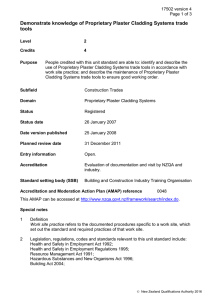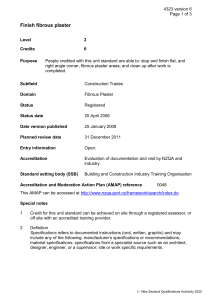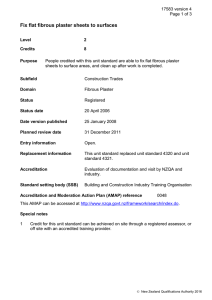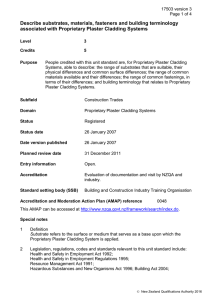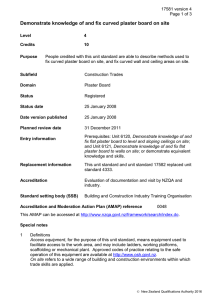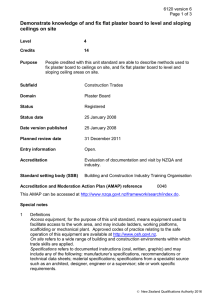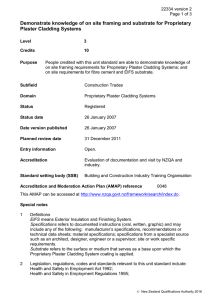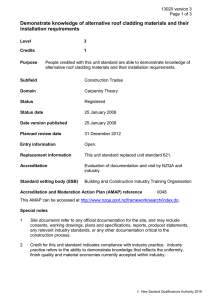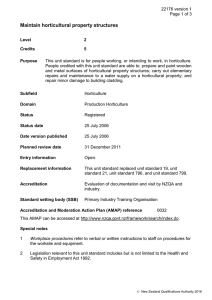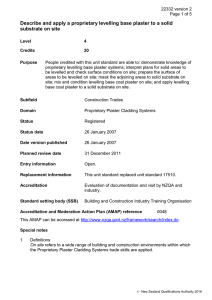Measure quantities, cost and quote for a Proprietary Plaster Cladding
advertisement
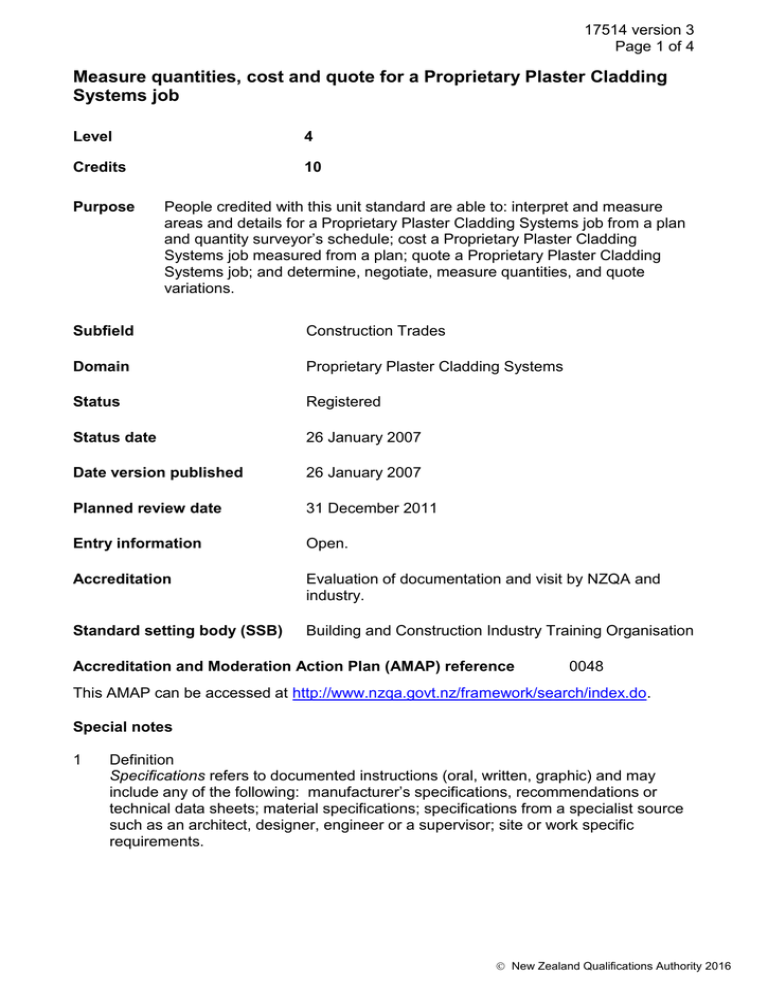
17514 version 3 Page 1 of 4 Measure quantities, cost and quote for a Proprietary Plaster Cladding Systems job Level 4 Credits 10 Purpose People credited with this unit standard are able to: interpret and measure areas and details for a Proprietary Plaster Cladding Systems job from a plan and quantity surveyor’s schedule; cost a Proprietary Plaster Cladding Systems job measured from a plan; quote a Proprietary Plaster Cladding Systems job; and determine, negotiate, measure quantities, and quote variations. Subfield Construction Trades Domain Proprietary Plaster Cladding Systems Status Registered Status date 26 January 2007 Date version published 26 January 2007 Planned review date 31 December 2011 Entry information Open. Accreditation Evaluation of documentation and visit by NZQA and industry. Standard setting body (SSB) Building and Construction Industry Training Organisation Accreditation and Moderation Action Plan (AMAP) reference 0048 This AMAP can be accessed at http://www.nzqa.govt.nz/framework/search/index.do. Special notes 1 Definition Specifications refers to documented instructions (oral, written, graphic) and may include any of the following: manufacturer’s specifications, recommendations or technical data sheets; material specifications; specifications from a specialist source such as an architect, designer, engineer or a supervisor; site or work specific requirements. New Zealand Qualifications Authority 2016 17514 version 3 Page 2 of 4 2 Legislation, regulations, codes and standards relevant to this unit standard include: Health and Safety in Employment Act 1992; Health and Safety in Employment Regulations 1995; Resource Management Act 1991; Hazardous Substances and New Organisms Act 1996; Building Act 2004; Construction Contracts Act 2002; New Zealand Standards, NZS 4218:2004 Energy efficiency – Small building envelope and NZS 3604:1999 Timber Framed Buildings, available from Standards NZ (http://www.standards.co.nz); New Zealand Building Code; Territorial Authorities’ building regulations. Elements and performance criteria Element 1 Interpret and measure areas and details for a Proprietary Plaster Cladding Systems job from a plan and quantity surveyor’s schedule. Range cladding system, brick or block levelling, junctions, reveals, parapets, mouldings, special flashings, finishes. Performance criteria 1.1 The selected Proprietary Plaster Cladding System required is translated into area quantity from the plan and the details described or specified in architectural/designer drawings and specifications. 1.2 The selected Proprietary Plaster Cladding System is translated from a quantity surveyor’s schedule and the associated specifications. Element 2 Cost a Proprietary Plaster Cladding Systems job measured from a plan. Performance criteria 2.1 The make-up and application of metre rates as a costing method are identified and described according to the substrate and finish. Range 2.2 Proprietary Plaster Cladding System substrate, plaster finish type, architectural mouldings, surface coatings. The unit costs are identified as a costing method and described according to the substrate and finish. Range materials, establishment, labour, supervision, overheads, profit. New Zealand Qualifications Authority 2016 17514 version 3 Page 3 of 4 Element 3 Quote a Proprietary Plaster Cladding Systems job. Performance criteria 3.1 Building contracts and contract requirements are identified and interpreted in terms of the job requirements. Range timely performance, remedy, penalties, insurance, retention payments, variations. 3.2 Contract quotes are written to cover job requirements and are consistent with the specifications and plans. 3.3 Procedures after a quotation is submitted are explained in terms of follow up and confirmation. Element 4 Determine, negotiate, measure quantities, and quote variations. Performance criteria 4.1 A variation to the original plan, specification and quote is identified and the impact determined in terms of work and rework. Range 4.2 Negotiation of the variation is described in terms of the involved parties. Range 4.3 three of – builder, designer, developer, owner, supplier, manufacturer, subcontractor. The variation is measured and quoted prior to commencement of work or rectification of work, and addresses issues arising in terms of the job requirement. Range 4.4 additional areas, rework, construction damages, architectural or designer error. materials, establishment, labour, supervision, overheads, profit. Confirmation of the variation order is obtained before work commences. Range written authorisation, oral authorisation. Please note Providers must be accredited by the Qualifications Authority, or an inter-institutional body with delegated authority for quality assurance, before they can report credits from assessment against unit standards or deliver courses of study leading to that assessment. New Zealand Qualifications Authority 2016 17514 version 3 Page 4 of 4 Industry Training Organisations must be accredited by the Qualifications Authority before they can register credits from assessment against unit standards. Accredited providers and Industry Training Organisations assessing against unit standards must engage with the moderation system that applies to those standards. Accreditation requirements and an outline of the moderation system that applies to this standard are outlined in the Accreditation and Moderation Action Plan (AMAP). The AMAP also includes useful information about special requirements for organisations wishing to develop education and training programmes, such as minimum qualifications for tutors and assessors, and special resource requirements. Comments on this unit standard Please contact the Building and Construction Industry Training Organisation national.office@bcito.org.nz if you wish to suggest changes to the content of this unit standard. New Zealand Qualifications Authority 2016
